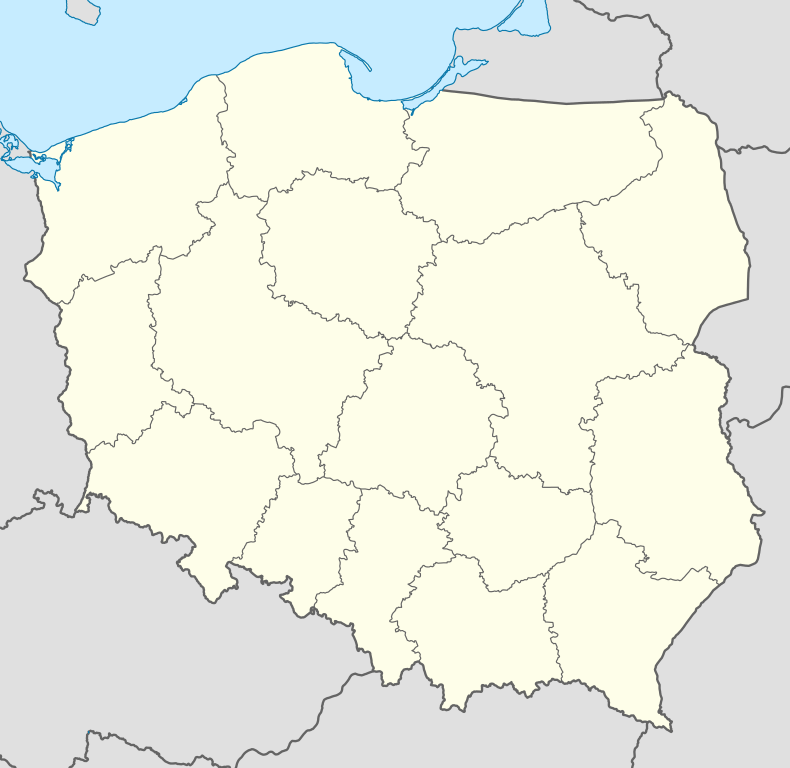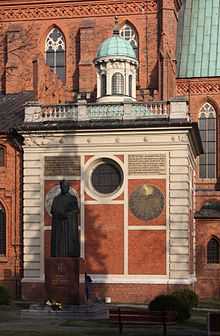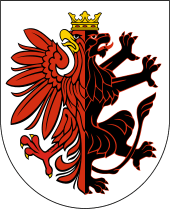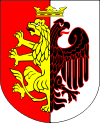Włocławek
| Włocławek | |||
|---|---|---|---|
|
Collage of views of Włocławek. Top: View of Old Town, Middle of left: The monument on the Liberty Square, Center: Przechodnia Street, Middle of right: Cathedral, Bottom left: Shopping center Wzorcownia in faiance factory, Bottom right: The Bridge of Marschall Edward Rydz-Śmigły | |||
| |||
 Włocławek | |||
| Coordinates: 52°39′33″N 19°04′05″E / 52.65917°N 19.06806°E | |||
| Country |
| ||
| Voivodeship | Kuyavian-Pomeranian | ||
| Powiat | city county | ||
| Established | 10th century | ||
| Town rights | 1255 | ||
| Government | |||
| • Mayor | Andrzej Pałucki | ||
| Area | |||
| • City | 84.32 km2 (32.56 sq mi) | ||
| Population (2011) | |||
| • City | 116,345[1] | ||
| • Metro | 210,516 (2005)[2] | ||
| Time zone | CET (UTC+1) | ||
| • Summer (DST) | CEST (UTC+2) | ||
| Postal code | 87-800 to 87-810, 87-812, 87-814, 87-816 to 87-818, 87-822 | ||
| Area code(s) | +48 54 | ||
| Car plates | CW | ||
| Website | http://www.wloclawek.pl | ||

Włocławek [vwɔt͡sˈwavɛk] is a town in central Poland, situated on the rivers Vistula (Wisła) and Zgłowiączka, with a population of 116,345 (December 2011).[1] It is located in the Kuyavian-Pomeranian Voivodeship and until 1999 it was the capital of Włocławek Voivodeship.
History
The history of Włocławek can be stretched back to the times of the Iron Age: archeological excavations conducted on the site of today's city uncovered the remains of a settlement belonging to the Lausitz culture, on which around 500 years later a settlement of Pomeranian culture had been established. Traces of settlements dating from the Roman period and the early Middle Ages have also been excavated and uncovered.[3]
Regarding the city itself, precise dating of its founding has proven do be difficult. Since the 16th century there is conflicting data in relation to the establishment of the town. Part of the confusion lies with varying attributions of the city's name, (which was derived from the first name Władysław, or Vladislav), to three rulers: Władysław II the Exile, his grandfather Władysław I Herman, or Vladislav II of Bohemia.
An assistant to the Archbishop of Gniezno was mentioned as residing in the town in 1123 and the Diocese of Włocławek (Latin: Vladislaviensis) in Kuyavia in the bull issued by Pope Eugene III in 1148. The first bishop of Włocławek, whose name appears in the bull was Warner, and he was followed by an Italian named Onoldius. The diocese was also recorded as "Włocławek and Pomerania" (Vladislaviensis et Pomeraniae).
Włocławek received its town rights in year 1255. During the 14th and 15th centuries the city was destroyed and also captured several times by the Teutonic Knights, who renamed it Leslau. Peace treaty was signed in year 1466, Treaty of Thorn, and the city prospered from its involvement in the trade with grain. During the Swedish invasion Second Northern War the city was partially destroyed in 1657. After the Second Partition of Poland in 1793 Włocławek became part of Prussia. The Congress of Vienna restored it to Congress Poland, but the city was later occupied by the Russian Empire since 1831. The city was again destroyed during the battles of German offensive during the First World War.
During World War II, Włocławek was occupied by German troops, which entered the city on 14 September 1939. Under the Nazi occupation Włocławek was again renamed Leslau, annexed by decree to the German Reich on 8 October 1939 and administered from 26 October as a part of Reichsgau Posen (renamed on 29 January 1940 Reichsgau Wartheland). One third of the city was destroyed, but its factories and workshops were rebuilt by the Polish government in the following decades. The most important industries in Włocławek today are chemical industry, production of furniture, and food processing. The dam which was constructed in 1969 regulates the water level of the Vistula river, forming Włocławek Reservoir.
The Catholic priest Fr. (now Blessed), Jerzy Popiełuszko, who was associated with the workers' and trade union movement Solidarity, and who was also a member of opposition to the Communist regime in Poland, was tortured and murdered by three Security Police officers, and was thrown into the Włocławek Reservoir, close to the city. His body was recovered from the reservoir on October 30, 1984.
From 2012 the city is part of the Special Economic Zone - Włocławek Economic Development Area – Industrial and Technological Park with tax-free areas and incentives for investors.[4]
Jewish history
The Jewish population increased from 218 (6,6%) in 1820 to 6,919 in 1910 (20,5%) and 13,500 in 1939. One of the founders of the Mizracḥi movement, rabbi Leib Kowalski (1895–1925), lived and worked in Wrocławek. During the interbellum period, the town had several Jewish schools (primary and high schools), two yeshivas, and three Jewish sports clubs.[5] With the beginning of the German occupation of Poland, Włocławek became the first town in Europe in which Jews were required to wear the yellow Star of David badges. Wrocławek ghetto was created in November 1940. The Nazis deported 3,000 Wrocławek's Jews to various places between December 1939 and June 1941. Some 2,000 Jews were deported to Łódź and to Chełmno extermination camp between 26 and 30 September 1941. The ghetto was burnt in late April 1942.[5] Many of the Włocławek's Jews died of starvation or illness, were shot or beaten to death by the Nazis after being confined in the Łódź Ghetto. Others perished in the gas chambers upon their arrival at the Chełmno extermination camp. Today there is only very little, if any trace at all, of their once rich and lively community. We can find also a Table for victims of Jewish ghetto Grzywno in Włocławek (Polish Tablica Ofiar Ghetta we Włocławku) and Jewish Cemetery at Municipal/ Communal Cemetery (Polish Cmentarz Komunalny we Włocławku).
Historical monuments
- Copernicus Square
Copernicus Square (Polish Plac Kopernika) – in the cathedral school by Basilica Cathedral of St. Mary Assumption in Włocławek studies Nicolaus Copernicus in 1488-91. Together with his teacher, Mikołaj Wódka (Abstemius), built a sun watch that we can see on Cathedral Basilica. All history we can read in The Solar Mystery of Prof. Jeremi Wasiutynski. We can see here the monument of Nicolas Copernicus, the main office of the Higher Seminary, founded in 1569 (first seminary in Poland, and also one of the oldest in the world).[6]
- St. Witalis Church
St. Witalis Church, 1330, is the oldest Gothic building in Włocławek. In the interior there are beautiful works of Polish 15th-century painting – triptych with the scene of St. Mary’s crowning (1460). In front of Basilica Cathedral we can see a monument of famous Polish primate Stefan Wyszyński, who lived in Włocławek between 1917-46.[7]
- Basilica Cathedral of the St. Mary Assumption
Gothic Cathedral under the name of the St. Mary Assumption (Polish Katedra pw. Najświętszej Marii Panny) was built in 1340-1411 and then have other rebuilds. It is one of the oldest and highest (86 m) churches in Poland. The most important monuments are:
- - Tombstone of Piotr from Bnin, sculpted by Wit Stwosz - 1493,
- - Chapter house - 1521,
- - Renaissance chapel - 1604-1611,
- - Gothic stain glass windows - 1360, oldest ones in Poland,
- - Tombstone of Marcin Talibowski (1493),
- - Painting of Francisco de Zurbarán - 17th century,
- - The Tumski Crucifix,
- - Largest painting on a single board in Poland dating - 1470,
- - Stain glass windows - by Józef Mehoffer
- - Sculpture The Last Supper (1505)
- - Painting of Juan Correa de Vivar - 1565,
- - Eucharistic Throne – one of the most magnificent silver masterpieces in Europe - 1744,
- - Candelabrum by Hans Meyer - 1596 [8]



- Municipal Park of Henryk Sienkiewicz
Municipal Park named after Henryk Sienkiewicz (Polish Park Miejski im. Henryka Sienkiwicza) -is one of the oldest parks in Poland. We can see here a bust of Henryk Sienkiewicz famous writer (for example Nobel Prize for Quo Vadis).
- Bishop’s Palace
Bishop’s Palace (Polish Pałac Biskupi) is on the Gdanska street on the river. Bishop’s residence from 1858-61 have a garden.
- Vistula’s Boulevards of Marshall Józef Piłsudski
Vistula’s Boulevards of Marshall Józef Piłsudski (Polish Bulwary im. Marszałka Józefa Piłsudskiego) - here are many import ant building: Old houses on the Old Marketplace, Church of St. John the Baptist, Bridge of Marschall Edward Rydz-Smigły, Art Museum, Ethnographic Museum, high schools or Marshal Office.
- Culture center Brewery B
In the former brewery from 1832 we will find modern culture center. Here is concert hall, culture associations, small cinema, museum of measurement and café.[9]
- Black Granary
Black Granary (Polish Czarny Spichrz) was built between the 18th and 19th centuries. It is the only construction of that kind, that is still existing in Poland. Here is the Dobrzynsko-Kujawskie Cultural Society and the Art Club Piwnica.
- Church of St. John the Baptist
Church of St. John the Baptist (Polish Kościół pw. Św. Jana Chrzciciela) have Gothic and Baroque style, brick-layered, from 1538. We can see an interior in Baroque style:
- - Guardian Angel painting (1635),
- - baroque font - 17th century,
- - Rococo pulpit - 18th century,
- - sculpture of John Baptist from Venice (Polish Jan Baptysta Wenecjanin).
- All Saints church and Franciscan-Reformers cloister
All Saints church and Franciscan-Reformers cloister (Polish Parafia i Klasztor Ojców Franciszkanów) was built in 1639-1644, in Baroque style with Gothic elements. We can see Baroque aisle and Rococo altars from the 18th century.
- Evangelical church
Evangelical church (Polish Kościół Ewangelicki) was built 1877-79, but in the 17th century was here a wooden church. We can see here interesting altar with painting in convention of Paul Delaroche.
- Liberty (Freedom) Square
Liberation Square (Polish Plac Wolności) It is the town’s central square, with the monument dedicated to the Polish soldiers of the II World War, a hotel Zajazd Polski (18th century), restaurant, banks and shops. We see also All Saints church and Franciscan-Reformers cloister, Mühsam Palace from the 19th century.
- The stage of fall on the Vistula river
The stage of fall on the Vistula (Polish Zapora Wodna na Wiśle, Tama we Włocławku) river was built in 1970 and is the biggest unnatural lake in Poland. There is a tragic event related to this place. Here in the Vistula river priest Jerzy Popiełuszko found his death. On the right river’s bankhas been placed a monumental crucifix.
- Wzorcownia
Shopping and entertainment center in the former faience factory of Teichefeld & Atserblum from 1873.[10][11]
- Green Market
Green Market (Polish Zielony Rynek) is the historical place of trade. There are here tenement houses from 19th and 20th century, where we can find baker's shop, confectionary store or mart with clothes stores. Here is also Main City Office with Mayor's Bureau and Gallery of Modern Art.[12]
- Municipal Cemetery
Municipal/ Communal Cemetery (Polish Cmentarz Komunalny we Włocławku) - central cemetery in the city between streets: Komunalna, Chopina, Aleja Królowej Jadwigi. There are here parts: Polish, Jewish, German (Protestants, Evangelicals), Russian (Russian-Orthodox Church), victims of 1. and 2. World War. Here is also the Russian Orthodox Church.
Museums

- Diocesan Museum
Next to Basilica Cathedral there is famous Diocesan Museum (Polish Muzeum Diecezjalne) with paintings of Francesco Barbieri (Guercino), group of Caravaggio or graphs of Albrecht Dürer. We can see also Seminary Library of Chodynski Brothers with beautiful books, for example missals from 1500.
- Museum of the Kujawy and Dobrzyn land
Main Edifice
We can see here 2 stable exposition : "Włocławek`s Faience", "The Gallery of Polish portraits" with Józef Simmler, Teodor Axentowicz, impressionism by Leon Wyczółkowski, symbolism by – Jacek Malczewski and Vlastimil Hofman, secession by – Józef Mehoffer, Stanisław Ignacy Witkiewicz, Wojciech Kossak, Alfons Karpiński, Olga Boznańska (1920s and 1930s), Anthony van Dyck or Marcello Bacciarelli.
The Ethnography Museum
There is in granary of a project of Franciszek Tournelle. It shows the most important elements of folc culture and equipment of house interior and farm of Kujawy :
farming,
breeding,
fishing preceding
pottery,
blacksmith,
cart-wrighting,
cooperage,
plaiting,
historic folk sculpture,
shrovetide customs,
musical instruments.
The Museum of the History of Włocławek
There is in two historic baroque houses from the 16th and 18h century on the Old Market. It shows monuments about the history of Włocławek and Poland from archaeological excavations to Liberation of Włocławek 1945. We can see:
"The Bowl of Włocławek" (10th century) and elements of knights (14th and 15th century),
economic life of Włocławek (16th and 17th century),
measures and weights,
treasure with coins from the 12th to 18th centuries,
pharmaceutics from the 19th and 20th centuries,
memorabilia of big industry in the 19th century,
memorabilia of the Fire Department,
sports trophies,
uniforms, firearms, weapons, photographs and the archives of national uprisings, Polish-Soviet war (1919-1921), interwar decades, and World War I and II
models of non-existent buildings (city hall, St. Wojciech Church and St. Mikołaj Orthodox Church).
reconstruction of a photo atelier
The Art Collection
We can find big art collection in a rick granary from 1839. We can see here two stable exposition: religious, human and animal sculptures by Stanisław Zagajewski – “Polish Gaudi” from group of l`art brut and an exhibition of Wacław Bębnowski (ceramic sculptures and functional objects with art nouveau motifs, naked nymphs and elements of the Far East).
Sometimes are open for tourist expositions of Italy, Germany or Netherlands (17th/18th centuries):
Paintings of Carlo Cignani, Georg Philipp Rugendas, Francesco de' Rossi,
graphs of Rembrandt van Rijn, Albrecht Altdorfer, Heinrich Aldegrever, Parmigianino, Vespasiano Strada oder Lucas van Leyden.[13][14][15]
Włocławek districts
- Michelin
- Południe (South)
- Rybnica
- Śródmieście (City Centre)
- Wschód Leśny (East Forest area)
- Wschód Mieszkaniowy (East Residential area), a.k.a. Dzielnica Wschód (Eeast District)
- Wschód Przemysłowy (East Industrial area), a.k.a. Dzielnica Wschód (Eeast District)
- Zachód Przemysłowy (West Industrial area)
- Zawiśle
- Zazamcze





.jpg)
.jpg)

Culture and free time
- Culture center Browar B
- OSIR - Sports center with new Football Area, Swimming pool, Aqua park, tennis courts or sea resorts
- Yacht area and Poland Camping in Marina Zarzeczewo (Yacht Club Anwil)
- Wakepark Włocławek
- Yacht area of WTW Włocławek
- Culture center Włocławskie Centrum Kultury
- Theater: Teatr Impresaryjny im. W. Gniazdowskiego, Teatr "Nasz", Teatr Skene
- Gallery of Modern Art Galeria Sztuki Współczesnej
- Music clubs und Discos, the most famous are Million Club (here played: Marc van Linden or Tom Novy), Starodebska Music Bar or Music club at Lucky Star Bowling Wzorcownia
- Nature park Gostynińsko-Włocłąwski Park Krajobrazowy with over 40 lakes
- Rope parks: Park Linowy Włocławek Jezioro Czarne (at Lake Czarne) or Park Linowy Włocławek Aleja Kazimierza Wielkiego (at Kazimierz Wielki Avenue)
- Airport Kruszyn and Aeroklub Włocławek
- Shopping and entertainment center Wzorcownia Włocławek
- Shopping mall Focus Park Włocławek
- Horse clubs: Arabians Falborek, Pensjonat Michelin, Klub Jeździecki Bogucin
- Golfclub Kujawy
- Diving center Mr Jacques
- Quad-Park in Włocławek.
- Fitness and Gymnastic clubs: Klub Forma, Pure Fitness or Herkules.
- Judo and Karate Center for example IKT
- Games center: Lucky Star Bowling Wzorcownia (bowling, snooker, darts, pinball etc.) or Sport Bowling Włocławek
- Paintball clubs
- Water sports center Yacht Club Anwil
- Long ways for bicycles,[10][16][17]
Sports clubs
- Anwil Włocławek - men's basketball team, former Polish Champion, 4th in Era Basket Liga in 2003/2004 season.
- Kujawiak Włocławek - men's football team, winner of regional 3rd league group 2004, promoted to play in 2nd league in season 2004/2005.
- Włocłavia Włocławek - men's football team.
- Włocławek Rowing Association (Włocławskie Towarzystwo Wioslarskie) - rowing team, former Polish and world Champions; created in 1886.
Business
According to Rzeczpospolita report:[18] the major corporations are:
- Anwil SA - Orlen Group, Poland
- Brügmann sp. z o.o., Salamander Industrie Produkte Group, Germany
- Guala Closures DGS Poland SA - Italy
- Indorama Ventures Poland sp. z o.o., India/Thailand
- PSH Lewiatan - Poland
- Wika Polska sp. z o.o. sp. k. - Germany
There are many other international companies: Delecta (Rieber&Son)- Orkla Group, Norway; Top2000 - Hamelin Group, France; Drumet - WireCo Group, USA; Kujawianka/ ATlanta Poland (Bakal Group), Poland; ACPCO2 - Belgium; Koło, Sanitec Group - France; Teutonia, Newell Rubbermaid Group - USA; Solvay - Belgium; ACV- Belgium; Remwil, Orlen Group, Poland; Budizol, Poland; Naturana - Germany; PV Prefabet, PV Group - Germany. Many transport and logistic companies has branches in or near the city.
From 2012 the city is part of the Pommeranian Special Economic Zone - Włocławek Economic Development Area – Industrial and Technological Park with tax-free areas and incentives for investors.[19] The city is directly at A1 highway and near to A2 highway, directly to 3 nationalways (Polish Drogi Krajowe), riverway (Vistula) to Gdanks, Berlin or Warsaw and fast rail line with many directions.[20] Włocławek has also own energy plants (Power Plant of Anwil/ Orlen, Municipal Power Plant of City Włocławek, Water Power Plant on Vistula River).
Education
Currently are 5 universities/colleges or branches:
- Państwowa Szkoła Wyższa PSWW Włocławek/Higher State School in Włocławek PSWW (former PWSZ we Włocławku/ Higher Vocational State School PWSZ in Włocławek)[21]
- Wyższa Szkoła Humanistyczno-Ekonomiczna WSHE Włocławek/ College of Humanistics and Economics WSHE in Włocławek[22]
- Wyższa Szkoła Techniczna Włocławek / Higher Technical School in Włocławek[23]
- Wyższa Szkoła Informatyki i Umiejętności Łódź, branch in Włocławek/ Higher School of IT and Skills[24]
- Uniwersytet Mikołaja Kopernika w Toruniu Wydział Teologiczny we Włocławku (Wyższe Seminarium Duchowne Włocławek),[25][26]
High schools
- I LO im. Ziemi Kujawskiej, ul. Mickiewicza 6 in Włocławek is one of the best high school in the city and in the Kuyavian-Pomeranian Voivodeship
- History of the school
- In early 1900 the Committee of Civic, which was chaired by Louis Bauer requested the Ministry of Finance to set up a trade school. 27 April 1900, the Ministry of Finance agreed to the creation of Włocławskie Siedmioklasowej School of Economics. The founders of the school was 104 inhabitants. The school admitted students were between the ages of 8 to 11 years who, after the annual rate became the first class of students. Powers available to the school received a state school,
- Publiczne Liceum im. Jana Długosza we Włocławku
- II LO im. Mikołaja Kopernika, ul. Urocza 3
- III LO im. Marii Konopnickiej, ul. Bechiego 1
- IV LO im. Kamila Krzysztofa Baczyńskiego, ul. Kaliska 108
- V LO im. Unii Europejskiej, ul. Toruńska 77/83
Twin Areas
This area has twinning with the following:
People
- Sholem Asch - writer
- Bronisław Dembowski (b. 1927), bishop of Włocławek (1992–2003)
- Anton Denikin - commander in chief of Russia's army
- Roman Kozłowski, paleontologist
- Leon Marchlewski- chemist, one of the founders in the field of chlorophyll chemistry
- Aharon Megged
- Henryk Muszyński- Polish bishop
- Jan Nagórski, the first man to fly over the North Pole
- The Blessed Jerzy Popiełuszko, martyred near Włocławek in 1984
- Marcel Reich-Ranicki - "Pope of literature's critic", had one of the most important TV-shows in Germany
- Tadeus Reichstein - Nobel-Prize Winner in chemistry
- Maryla Rodowicz - famous Polish Singer
- Chaim F. Shatan, physician who defined Post-Traumatic Stress Disorder
- Bernard Pullman - chemist
- Włodzimierz Stanny
- Jerzy Engel - coach of Polish football national team
- Józef Stolorz, renowned fine-art painter
- Jakub Świnka
- Henri Tajfel, social psychologist
- Stefan Wyszyński, enrolled in the Roman Catholic seminary in Włocławek, famous Polish bishop and cardinal
- Stanisław Zagajewski - fine-art sculptor
- Nicolaus Copernicus, astronomer, studied in the cathedral school in Włocławek in 1488-91, his teacher was Mikołaj Wódka (Abstemius), they probably built a sun watch, that we can see on Cathedral Basilica of the Assumption of Mary,[7][28]
- Lech Wałęsa, politician, Nobel prize winner, born in Popowo, 10 km of Włocławek
- Katy Carr, singer, she spent childhood in Włocławek
- Adam Palma, musician
References
- ↑ 1.0 1.1 "Ludność w gminach według stanu w dniu 31.12.2011 r.; bilans opracowany w oparciu o wyniki NSP’2011" (XLS). Central Statistical Office. 13 August 2012. Retrieved 4 February 2013.
- ↑ Erik Gløersen (2005). "Levels of polycentricity and preconditions for polycentric development in DEFRIS regions" (PDF). Nordregio. p. 6. Retrieved 4 February 2013.
- ↑ About Włocławek
- ↑ http://www.wloclawek.pl/strefa
- ↑ 5.0 5.1 Włocławek. "The YIVO Encyclopedia. Jews in Eastern Europe". Retrieved on 2015-03-12.
- ↑ glos.umk.pl/2010/04/kopernik/
- ↑ 7.0 7.1 http://www.naszwloclawek.pl/historia.php
- ↑ Włocławek Guidebook 2011, P. Nowakowski, MPEC Włocławek
- ↑ http://ckbrowarb.pl/
- ↑ 10.0 10.1 http://www.wloclawek.pl
- ↑ Włocławek i okolice, S. Kunikowski, Lega 2006
- ↑ Włocławek, Przewodnik Turystyczny, Andrzej Szczepański, UM WŁocławek
- ↑ http://www.muzeum.wloclawek.pl (in English too)
- ↑ Włocławek i okolice, J.Umiński, KAW 1989 and next
- ↑ http://www.aktywny.wloclawek.pl (in English too)</
- ↑ http://www.polen-digital.de/wloclawek/wloclawek-die-stadt-der-aktiven-erholung
- ↑ http://www.aktywny.wloclawek.pl
- ↑ Jeremi Jędrzejkowski, Anna Ogonowska-Rejer, lista największych polskich przedsiębiorstw, uszeregowana według przychodów, [w:] „Lista 2000 – polskie przedsiębiorstwa” (wydawana łącznie z „Rzeczpospolitą”), numer z 24 października 2012 r., s. 22-47
- ↑ http://www.wloclawek.pl/strefa/media/4/foldery/english.pdf
- ↑ http://visitwloclawek.blogspot.com/p/business.html/ Business chapter on a blog Visit Włocławek(English and German)
- ↑ http://www.psww.pl/
- ↑ http://wshe.pl/
- ↑ http://www.wst.wloclawek.pl/
- ↑ http://wsinf.edu.pl/wloclawek/
- ↑ http://web.diecezja.wloclawek.pl/wsd/index.htm
- ↑ http://www.teologia.umk.pl/
- ↑ 27.0 27.1 27.2 27.3 z aktualności Urzędu Miasta – Town Twinning
- ↑ http://www.glos.umk.pl/2010/04/kopernik/
External links
| Wikimedia Commons has media related to Włocławek. |
- Story of jews
- (English) Municipal website
- The history of Diocese of Włocławek in Catholic Encyclopedia (1913)
- (English and German) (Blog of tourism in Włocławek and Kujawy)
- (Polish) Website of tourist information
| ||||||||||||||||||||
| ||||||||||||
| ||||||||||||||||||||
Coordinates: 52°39′33″N 19°04′05″E / 52.65917°N 19.06806°E




